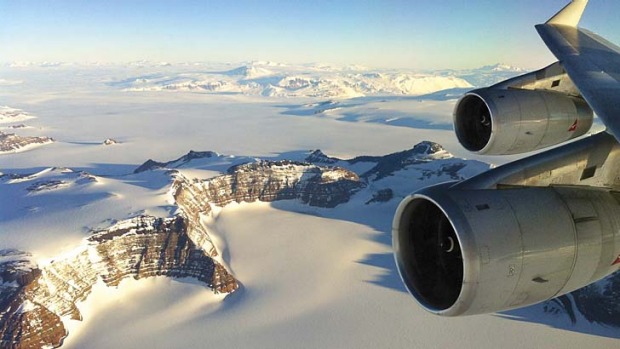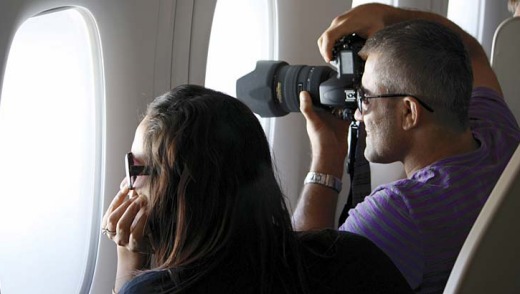
From 3000 metres, Lissa Christopher views the frozen continent on a flight-seeing tour - and she's home for dinner.
From where I'm sitting, it looks as though a giant has had a tantrum with a mother lode of wedding-cake icing. Enormous white fragments are strewn across the surface of the water for hundreds of kilometres. Over to the right, a herd of zebras is hoofing it through snow in the general direction of South America, and directly below, a pack of orcas is breaching foaming surf.
I'm not on drugs. I am on a long-range Qantas 747 on a sightseeing tour over Antarctica and my short-range brain is trying to make sense of the unusual circumstances. It is actually seeing hundreds of kilometres of fractured sea-ice and Antarctic mountains that are almost frozen over, some with ovals of dark rock showing through, others with stripes. They are about 3000 metres below and I'm looking at them from inside a metal tube that's travelling at hundreds of kilometres an hour.

No wonder it all seems a bit ... fantastic.
I'm in a window seat in premium economy. For the moment. At the halfway mark (about seven hours in), I will be obliged to swap places with one of the people in the central bank of seats who, unless they stand up, can't see much at all. That is the deal with premium-economy tickets. Back in some parts of economy, there is no seat swapping at all.
The lucky ducks in business class have unimpeded views throughout, as I discover when I sneak up the aisle for a stickybeak. A charming young couple allow me to kneel at their feet and share their panorama. My, what a lot of legroom they have. They've paid about $6000 each for it. The people in the no-rotation "centre economy" seats have paid about $1000 each.
All passengers are free to move about the cabin but are asked to do so only within their "booked class of travel". There are several reminders, and presumably it's not because business-class passengers are moving back to economy.
Our first glimpse of Antarctica is about 4½ hours into the flight, and a lot of non-window passengers leap out of their seats. One man's lens cap dangles in my lap as he leans across the aisle seat and then across me to get his camera to the window. Another man's elbow nudges my ear as he leans across the back of my seat to get his camera in position.
Things settle down once everyone realises the view isn't going to disappear before they can record it. As the captains (there are three in the cockpit) promise, the plane does a figure of eight around each area of interest so both sides of the plane get a good gawk.
I knew the plane would be flying at far lower altitudes than normal, for obvious reasons, and presumed the price would be a fair bit of turbulence, but I've been on inner-city bus rides bumpier than this. As Captain Steve Cairns explains later, the freezing environment means there's no hot air rising, therefore little or no turbulence. "I've never had a bumpy day down there," he says. "And I've been 11 times."
Sunglasses were recommended and I'm glad I remembered mine. It's brighter than a set of Hollywood dentures up here.
After a few smooth loops around the Transantarctic Mountains (the zebras and orcas), Cape Adare and Mount Minto, the plane heads off to Mawson's Hut, where more cloud-free airspace is expected.
Finding clear sky on these flights isn't easy and the weather is notoriously changeable. If there's a lovely bit of clear sky just outside the lowest permissible altitude, that's too bad. "The safety altitudes are inviolate," Cairns says.
Despite the meteorological challenges, however, he says he has enjoyed fine sightseeing on every Antarctic tour. The tours run during a short summer season; there are about 15 possible flight paths and a lot of route planning involved, but zero visibility is, nonetheless, a possibility.
On this flight, Antarctic expeditioner Peter Hicks is in the cockpit with the pilots, providing expert commentary. He does a fine job of it, piping up judiciously with all sorts of interesting titbits. He explains why some icebergs are smooth, like tablets, and others are pointy and eroded, like rotten molars; why there are odd patches of blue in the snow; and he encourages us to imagine the grim moment when Mawson arrived back at Cape Denison to discover his ship sailing off without him.
As we fly over Dumont d'Urville, the French scientific station, Hicks points out that while the French have built themselves a terrific airstrip, they've had trouble getting access to it. The local Adelie penguins think it's terrific, too, and keep coming back to nest on it. Not at its edges, mind you, but in the middle of it.
The hospitality and food at the French camp is great, he says, and "you should drop by if you ever get the chance". Note to self: next time passing by Antarctica, stop by Dumont d'Urville. Great nosh.
As we track along the northern coastline, small glaciers ooze out of gaps between cliffs and form grey folds in the water. They look a bit like elephant feet. Further inland, unblemished white snow and ice stretches for hectare after hectare. While I do find myself longing to get closer - to make footprints in that unmarred snow, to experience the silence and the air quality, to be within reach of the ice - the unique panorama that comes with altitude has its own rewards.
Once the sightseeing component of the tour is over, there's nothing left to do but sit back and enjoy the five-hour return flight. There's a marriage proposal in row 50, a medical issue in deep economy that's quietly resolved, a second meal service and the opportunity to get your photo taken with a man in a penguin suit.
As we approach the airport, we hear again the calm exchange of mysterious codes between heaven and earth. The cockpit's communications with air-traffic control during takeoff and landing are broadcast over the PA system.
In the taxi queue outside the airport, it feels strange to be back where we started, after 14 hours in the air. Remarkable, icy images are etched in my memory and I feel privileged, though it's a long time on a plane to look at a view through a small window. Another expeditioner in the queue, talking on a mobile phone, has no reservations. "After today, I can die happy," she tells her caller.
FAST FACTS
Antarctica Sightseeing Flights runs the only Antarctica sightseeing flights departing from Australia. The next tour from Sydney is on February 10, 2013. The next tour from Melbourne is on December 31, 2012. Prices range across seven classes of travel, starting at $1199 for an economy centre seat (no seat rotation) and rising to $6999 for "ice class". First-class seats are available on the New Year's Eve flight only and cost $7499. Phone 1800 633 449 or (03) 8814 5701, see antarcticaflights.com.au.